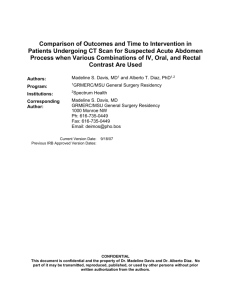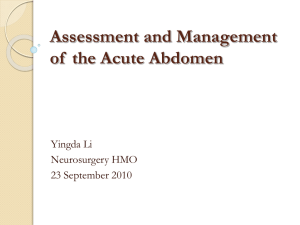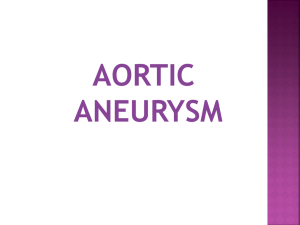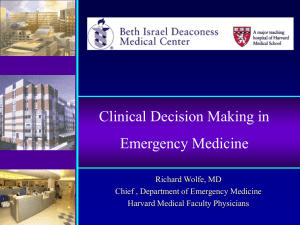References
advertisement
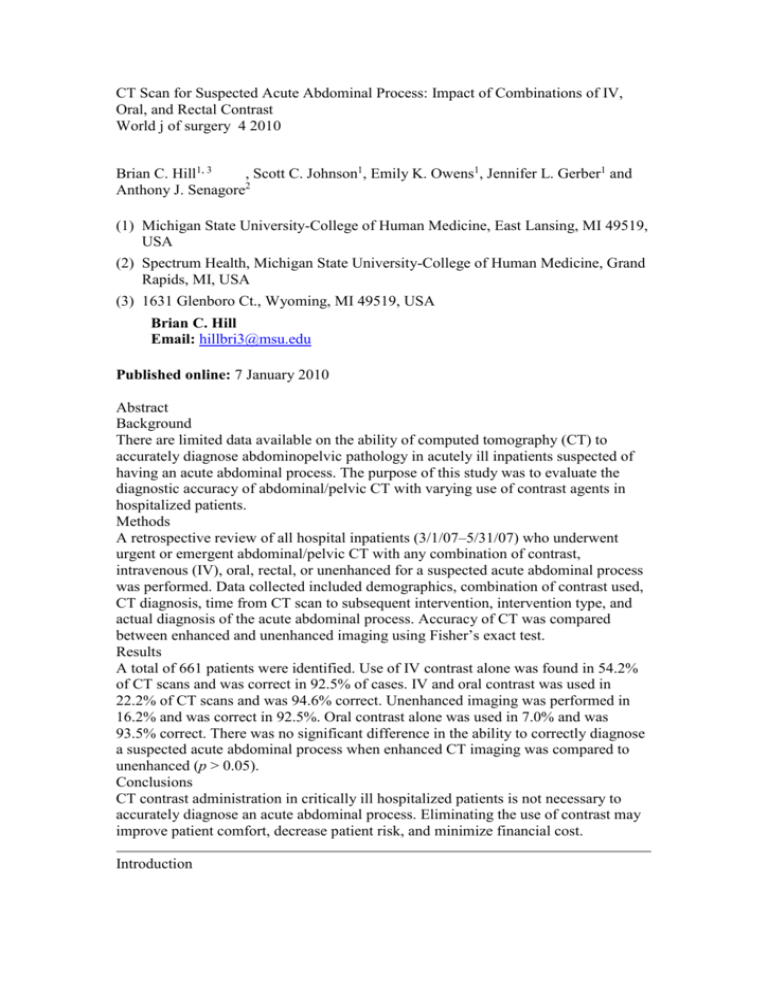
CT Scan for Suspected Acute Abdominal Process: Impact of Combinations of IV, Oral, and Rectal Contrast World j of surgery 4 2010 Brian C. Hill1, 3 , Scott C. Johnson1, Emily K. Owens1, Jennifer L. Gerber1 and Anthony J. Senagore2 (1) Michigan State University-College of Human Medicine, East Lansing, MI 49519, USA (2) Spectrum Health, Michigan State University-College of Human Medicine, Grand Rapids, MI, USA (3) 1631 Glenboro Ct., Wyoming, MI 49519, USA Brian C. Hill Email: hillbri3@msu.edu Published online: 7 January 2010 Abstract Background There are limited data available on the ability of computed tomography (CT) to accurately diagnose abdominopelvic pathology in acutely ill inpatients suspected of having an acute abdominal process. The purpose of this study was to evaluate the diagnostic accuracy of abdominal/pelvic CT with varying use of contrast agents in hospitalized patients. Methods A retrospective review of all hospital inpatients (3/1/07–5/31/07) who underwent urgent or emergent abdominal/pelvic CT with any combination of contrast, intravenous (IV), oral, rectal, or unenhanced for a suspected acute abdominal process was performed. Data collected included demographics, combination of contrast used, CT diagnosis, time from CT scan to subsequent intervention, intervention type, and actual diagnosis of the acute abdominal process. Accuracy of CT was compared between enhanced and unenhanced imaging using Fisher’s exact test. Results A total of 661 patients were identified. Use of IV contrast alone was found in 54.2% of CT scans and was correct in 92.5% of cases. IV and oral contrast was used in 22.2% of CT scans and was 94.6% correct. Unenhanced imaging was performed in 16.2% and was correct in 92.5%. Oral contrast alone was used in 7.0% and was 93.5% correct. There was no significant difference in the ability to correctly diagnose a suspected acute abdominal process when enhanced CT imaging was compared to unenhanced (p > 0.05). Conclusions CT contrast administration in critically ill hospitalized patients is not necessary to accurately diagnose an acute abdominal process. Eliminating the use of contrast may improve patient comfort, decrease patient risk, and minimize financial cost. Introduction Optimal evaluation of a patient with a potential acute abdominal process with CT is generally considered to include administration of oral, rectal, and IV contrast. However, administration of contrast through these three routes in an urgent or emergent clinical setting may be constrained by underlying medical conditions or patient care issues. Few reports in the literature describe the interpretation of abdominal CT examinations in critically ill patient populations in the absence of the use of contrast. The majority of studies assessing the use of contrast with CT for abdominal/pelvic evaluation have focused on emergency department patients with a limited differential diagnosis. Therefore, the purpose of this study was to evaluate retrospectively the diagnostic accuracy of abdominal/pelvic CT with varying use of contrast agents in a surgical teaching service located at a large teaching hospital. Methods This study was a retrospective review of all hospital inpatients from the Spectrum Health, Butterworth Campus, undergoing urgent or emergent abdominal/pelvic CT with any combination of contrast (unenhanced, IV, oral, or rectal) for a suspected acute abdominal process from March 1, 2007 through May 31, 2007. The indication for imaging was at the discretion of the treating physician, but the primary indication was failure to improve or clinical deterioration with concern for an abdominopelvic source of pathology. Patients who received CT as part of a kidney stone protocol or for suspicion of appendicitis or diverticulitis were excluded. Approval of the study was obtained from the Institutional Review Board at Spectrum Health. Procedure notes, operative notes, and discharge summaries were reviewed to determine accuracy of the CT diagnosis and time and type of definitive treatment. Patient demographics, contrast used, CT diagnosis, time from CT scan to subsequent intervention, intervention type, and actual diagnosis of the acute abdominal process were recorded for all patients. Accuracy of CT diagnosis, as well as differences in sex, was compared between enhanced and unenhanced imaging using the Fisher’s exact test. In addition, differences in age between each of the contrast groups and the unenhanced group were determined using the one-way ANOVA, followed by Dunnett’s test. Significance was assessed at p < 0.05 for the quantitative data. Due to the need to perform multiple Fisher’s exact tests to compare each of the three contrast groups to the unenhanced group, the p value for significance was adjusted to p < 0.017. Results A total of 1,457 CTs were performed during the study period. We identified 661 patients who fit the inclusion and exclusion criteria. Patient demographic information is shown in Table 1. By far, IV contrast alone was the most common agent used in CT imaging (54.2% of cases; Fig. 1). The CT diagnoses were divided into general categories (Table 2). The most common diagnosis was no acute pathology followed by inflammatory and infectious. After the CT scan, a subsequent procedural intervention took place in 32.7% of the cases (216/661 patients), 18 of which had the diagnosis of no acute pathology on CT scan. Table 3 shows the frequency of intervention type after a CT scan that suggested acute pathology. The percentages of cases requiring an intervention, broken down by contrast type, are displayed in Fig. 2. The average time to intervention post-CT was 44.9 h. Table 1 Patient demographic information IV contrast IV and oral Oral contrast Unenhanced alone contrast alone Age (year)a 55.9 ± 17.8* 54.8 ± 17.8* 66.7 ± 17.4 65.8 ± 17.8 Sex (% 149/358 62/107 71/147 (48.3%) 20/46 (43.5%) b Male) (41.6%)* (57.9%) a Mean ± standard deviation; values followed by an asterisk are significantly different from the unenhanced group (p < 0.05) b Values followed by an asterisk are significantly different from the unenhanced group (p < 0.017); a lower p value was used to control for the use of multiple χ2 tests Fig. 1 Percentage of various combinations of CT contrast used (n = 661) Table 2 Percentage of common CT diagnoses by category (n = 661) Diagnosis Number (%) No acute findings 231 (34.9%) Inflammatory 118 (17.9%) Infectious 81 (12.3%) Obstructed bowel 80 (12.1%) Other 65 (9.8%) Vascular 51 (7.7%) Neoplastic 28 (4.2%) Posttraumatic 7 (1.1%) Table 3 Percentage of procedural intervention type performed after a CT diagnosis of an acute abdominal process (n = 430) Intervention Number (%) No intervention 232 (54%) Surgical 87 (20.2%) Aspiration/drainage 56 (13%) Further imaging 19 (4.4%) Sigmoid/colonoscopy 14 (3.3%) EGD/ERCP 10 (2.3%) Other 8 (1.9%) Cystoscopy 4 (0.9%) Fig. 2 Percentage of CT scans resulting in a procedural intervention based on contrast combination used Regardless of the combination of contrast used, the correct diagnosis was made 93% of the time (Fig. 3). The combination of IV and oral contrast led to an accurate diagnosis 94.6% of the time. There was no significant difference in the accuracy of CT diagnosis when any combination of contrast was compared to CTs performed without contrast. Fig. 3 Percentage of correct CT results based on contrast combination used Discussion There have been concerns regarding the possible overuse of CT as a diagnostic tool [1]. In 2000, the United States Food and Drug Administration estimated that a total of 45.1 million CTs had been performed in the United States [2]. Due to the radiation exposure, indiscriminate use of CT increases the risk of cancer, thereby minimizing the favorable benefit to risk ratio [1]. Our results support the notion that CT may be an overutilized resource because 34.9% (231/661) of the CT scans revealed no evidence of an acute abdominal process. Even when an acute abdominal process was discovered, only 46% (198/430) of these cases led to a subsequent procedural intervention. These findings support the necessity of employing alternative diagnostic tools as a means of minimizing the radiation exposure risks associated with CT. Despite the fact that contrast agents have been proposed to increase diagnostic accuracy of CT imaging [3–5], none are without risks or concerns. Oral contrast allows small bowel opacification and aids in the diagnosis of structural abnormalities (e.g., ulcers, perforations, obstructions, space-occupying lesions). However, limitations for the use of oral contrast include patient intolerance due to ileus, the need for intragastric administration via a tube, risk of vomiting and aspiration, and time between administration and CT study, which typically is 90 min. IV contrast is used to diagnose inflammatory-based lesions or for detection of bowel wall pathology and provides detail regarding arterial supply and venous drainage for abdominal organs. Situations that limit the use of IV contrast include allergy to iodine or impaired renal function. The latter is a common clinical finding in urgent and emergent clinical settings. Rectal contrast, administered via enema, fills the colon from the rectum proximally, possibly as far as the ileocecal junction. This allows for visualization of spaceoccupying lesions, obstructions, diverticula, anastomotic leaks, bowel perforation, and inflammatory bowel diseases affecting the large intestine. Limitations mainly involve restricted access to the anorectum or concern regarding contrast extravasation. Multiple studies have been performed in specific disease states involving the abdomen comparing the use of various combinations of contrast. However, these are limited to the emergency department setting. Nonetheless, the accuracy of unenhanced CT imaging has been supported by several of these studies [6–9]. Huyn et al. found they could shorten time to diagnosis of an acute abdomen an average of 68 min by performing a CT without contrast compared to contrast-enhanced CT [10]. One study found a 79% agreement between noncontrast enhanced and contrast enhanced CT for abdominal pelvic pain, attributing the discrepancy largely to interobserver variability [11]. Comparing unenhanced CT to three-view acute abdominal series, MacKersie et al. reported no change in any diagnosis among a small group of patients who underwent follow-up contrast-enhanced CT after initial unenhanced CT [8]. The presence of pericecal and periappendiceal fat inflammatory changes visible with unenhanced CT aid in the diagnosis of acute abdominal processes [7]. These changes, particularly in the case of diverticulitis or appendicitis, allow unenhanced CT imaging to be as effective as an IV contrast enhanced study [7, 9]. However, not all studies conclude that unenhanced CT imaging is as effective as those where contrast was used. Jacobs et al. concluded that the use of IV contrast significantly improved the radiologists’ ability to diagnose acute appendicitis or to establish an alternative diagnosis [12]. When the appendix was normal, an unenhanced study was as accurate as an IV enhanced study. Lane et al. noted that to increase the accuracy of unenhanced CT to a level comparable to enhanced CT, there must be sufficient understanding of abdominal anatomy, increased experience with unenhanced CT, and greater awareness of the appearance of signs suggestive of alternative diagnoses [13]. At our hospital, the standard protocol is to administer both oral and rectal contrast in addition to IV contrast when performing a CT scan for an acute abdominal process. However, this study reveals that actual implementation of the full protocol is rarely followed (3/661 cases) and often is influenced by the clinical situation and perceived risk or delay in imaging. The use of contrast agents in CT imaging is associated with several concerns. Most importantly, there is the burden of patient discomfort associated with administration of oral and rectal contrast. In addition, the CT scan is delayed while the contrast fills the desired portion of the alimentary canal. IV contrast use is limited to patients with adequate kidney function and has been implicated in causing severe hypersensitivity reactions. Finally, there is the financial cost associated with contrast use. Therefore, if contrast is not necessary for accurate diagnosis of an acute abdominal process, several aspects of patient care may be benefited without its use. Our findings suggest that when an acute abdominal process is suspected, the use of any contrast agent is not necessary to accurately diagnose the pathology. It does seem that the use of oral and IV contrast can slightly improve the diagnostic capabilities of CT (Fig. 3), but this difference is not statistically significant. Therefore, we are able to conclude that performing a CT scan on an inpatient suspected of having an acute abdominal process does not require contrast to yield an accurate diagnosis. Our findings from an inpatient setting corroborate the results from similar studies performed with emergency department patients [6–9]. When considering all aspects of CT in the inpatient setting (e.g., diagnostic outcomes, patient comfort, financial cost), eliminating the use of contrast for an acute abdominal process may be beneficial. Our study does have limitations. The sample sizes of the IV and oral contrast, unenhanced, and oral contrast only groups are relatively small compared with the IV contrast-only group. The study was not powered to assess differences between these contrast groups in regards to specific CT pathology and need for intervention but instead only for the accuracy of CT diagnostic capabilities. Additionally, patient comorbidities, other than age, were not considered in our study. Therefore, we cannot make conclusions regarding clinical decisions influencing the use of the various contrast agents. For instance, it is well known that as age increases glomerular filtration rate (GFR) decreases, putting an elderly patient at increased risk of developing IV contrast-induced nephropathy. The average patient age was significantly higher in patients who did not receive IV contrast (unenhanced and oral contrast only), suggesting that clinical consideration was given to the age-related decreasing GFR. However, our study did not measure GFR to confirm this. Comparing actual CT diagnoses and clinical outcomes, including interventions, between the various contrast groups and consideration of patient comorbidities would provide a benefit for future research in this area. Despite these limitations, the goal of the study, which was to assess the ability of CT to evaluate acute abdominal pathology as actually utilized clinically, was accomplished. The data should give some pause for greater clinical evaluation to decrease the rate of CT that do not lead to a specific intervention. Conclusions We believe that when evaluating an acute abdominal process from the inpatient setting, unenhanced CT imaging is reasonable and provides several advantages over the standard enhanced CT scan. However, as described previously, increased experience with the unenhanced technique is required before implementation of this recommendation. Acknowledgments The authors are grateful for Alan T. Davis, PhD and Tracy Frieswyk, BA for their guidance and advising throughout this project and their assistance editing this manuscript. References 1. Brenner DJ, Hall EJ (2007) Computed tomography—an increasing source of radiation exposure. N Engl J Med 357:2277–2284 2. Stern SH (2007) Nationwide Evaluation of X-Ray Trends (NEXT): tabulation and graphical summary of 2000 survey of computed tomography. (CRCPD publication no. NEXT_2000CT) Conference of Radiation Control Program Directors. http://www.fda.gov.login.ezproxy.library.ualberta.ca/cdrh/ct/2000survey.pdf. Accessed 3 January 2008 3. Balthazar EJ, Megibow AJ, Siegel SE et al (1991) Appendicitis: prospective evaluation with high-resolution CT. Radiology 180:21–24 4. Gore RM, Miller FH, Pereles FS et al (2000) Helical CT in the evaluation of the acute abdomen. Am J Roentgenol 174:901–913 5. Strömberg C, Johansson G, Adolfsson A (2007) Acute abdominal pain: diagnostic impact of immediate CT scanning. World J Surg 31:2347–2354 6. in’t Hof KH, van Lankeren W, Krestin GP et al (2004) Surgical validation of unenhanced helical computed tomography in acute appendicitis. Br J Surg 91:1641–1645 7. Basak S, Nazarian LN, Wechsler RJ et al (2002) Is unenhanced CT sufficient for evaluation of acute abdominal pain? Clin Imaging 26:405–407 8. MacKersie AB, Lane MJ, Gerhardt RT et al (2005) Nontraumatic acute abdominal pain: unenhanced helical CT compared with three-view acute abdominal series. Radiology 237:114–122 9. Mun S, Ernst RD, Chen K et al (2006) Rapid CT diagnosis of acute appendicitis with IV contrast material. Emerg Radiol 12:99–102 10. Huyn LN, Coughlin B, Wolfe JM et al (2004) Patient encounter time intervals in the evaluation of emergency department patients requiring abdominopelvic CT: oral contrast versus no contrast. Emerg Radiol 10:310–313 11. Lee SY, Coughlin B, Wolfe JM et al (2006) Prospective comparison of helical CT of the abdomen and pelvis without and with oral contrast in assessing acute abdominal pain in adult emergency department patients. Emerg Radiol 12:150– 157 12. Jacobs JE, Birnbaum BA, Macari M et al (2001) Acute appendicitis: comparison of helical CT diagnosis-focused technique with oral contrast material versus nonfocused technique with oral and intravenous contrast material. Radiology 220:683–690 13. Lane MJ, Liu DM, Huynh MD et al (1999) Suspected acute appendicitis: nonenhanced helical CT in 300 consecutive patients. Emerg Radiol 213:341–346
